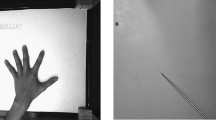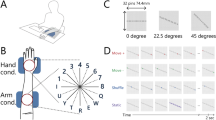Abstract
Various studies have shown subjects to mislocalize cutaneous stimuli in an idiosyncratic manner. Spatial properties of individual localization behavior can be represented in the form of perceptual maps. Individual differences in these maps may reflect properties of internal body representations, and perceptual maps may therefore be a useful method for studying these representations. For this to be the case, individual perceptual maps need to be reproducible, which has not yet been demonstrated. We assessed the reproducibility of localizations measured twice on subsequent days. Ten subjects participated in the experiments. Non-painful electrocutaneous stimuli were applied at seven sites on the lower arm. Subjects localized the stimuli on a photograph of their own arm, which was presented on a tablet screen overlaying the real arm. Reproducibility was assessed by calculating intraclass correlation coefficients (ICC) for the mean localizations of each electrode site and the slope and offset of regression models of the localizations, which represent scaling and displacement of perceptual maps relative to the stimulated sites. The ICCs of the mean localizations ranged from 0.68 to 0.93; the ICCs of the regression parameters were 0.88 for the intercept and 0.92 for the slope. These results indicate a high degree of reproducibility. We conclude that localization patterns of non-painful electrocutaneous stimuli on the arm are reproducible on subsequent days. Reproducibility is a necessary property of perceptual maps for these to reflect properties of a subject’s internal body representations. Perceptual maps are therefore a promising method for studying body representations.





Similar content being viewed by others
References
Culver CM (1970) Errors in tactile localization. Am J Psychol 83:420–427
Edwards MJ, Alonso-Canovas A, Schrag A et al (2011) Limb amputations in fixed dystonia: a form of body integrity identity disorder? Mov Disord 26:1410–1414. doi:10.1002/mds.23671
Franz SI (1913) The accuracy of localization of touch stimuli on different bodily segments. Psychol Rev 20:22
Franz SI (1916) The constant error of touch localization. J Exp Psychol 1:16
Guardia D, Lafargue G, Thomas P et al (2010) Anticipation of body-scaled action is modified in anorexia nervosa. Neuropsychologia 48:3961–3966
Hamburger HL (1980) Locognosia, the ability to localizate tactile stimuli on the body surface. Universiteit van Amsterdam, Amsterdam
Harrar V, Harris LR (2009) Eye position affects the perceived location of touch. Exp Brain Res 198:403–410. doi:10.1007/s00221-009-1884-4
Harrar V, Harris LR (2010) Touch used to guide action is partially coded in a visual reference frame. Exp Brain Res 203:615–620. doi:10.1007/s00221-010-2252-0
Inui K, Kakigi R (2011) Pain perception in humans: use of intraepidermal electrical stimulation. J Neurol Neurosurg Psychiatry. doi:10.1136/jnnp-2011-301484
Kennett S, Taylor-Clarke M, Haggard P (2001) Noninformative vision improves the spatial resolution of touch in humans. Curr Biol 11:1188–1191
Longo MR, Azañón E, Haggard P (2010) More than skin deep: body representation beyond primary somatosensory cortex. Neuropsychologia 48:655–668
Longo MR, Pernigo S, Haggard P (2011) Vision of the body modulates processing in primary somatosensory cortex. Neurosci Lett 489:159–163
Mancini F, Longo MR, Iannetti GD, Haggard P (2011) A supramodal representation of the body surface. Neuropsychologia 49:1194–1201. doi:10.1016/j.neuropsychologia.2010.12.040
McGraw KO, Wong SP (1996) Forming inferences about some intraclass correlation coefficients. Psychol Methods 1:30–46
Medina J, Coslett HB (2010) From maps to form to space: touch and the body schema. Neuropsychologia 48:645–654. doi:10.1016/j.neuropsychologia.2009.08.017
Moseley GL, Gallace A, Spence C (2012) Bodily illusions in health and disease: physiological and clinical perspectives and the concept of a cortical “body matrix”. Neurosci Biobehav Rev 36:34–46
Mouraux A, Iannetti GD, Plaghki L (2010) Low intensity intra-epidermal electrical stimulation can activate Adelta-nociceptors selectively. Pain 150:199–207. doi:10.1016/j.pain.2010.04.026
Nico D, Daprati E, Nighoghossian N et al (2010) The role of the right parietal lobe in anorexia nervosa. Psychol Med 40:1531–1539. doi:10.1017/S0033291709991851
Pillsbury WB (1895) Some questions of the cutaneous sensibility. Am J Psychol 7:42–57
Portney LG, Watkins MP (2009) Foundations of clinical research: applications to practice. Prentice Hall, Upper Saddle River
Serino A, Haggard P (2010) Touch and the body. Neurosci Biobehav Rev 34:224–236. doi:10.1016/j.neubiorev.2009.04.004
Shrout PE, Fleiss JL (1979) Intraclass correlations: uses in assessing rater reliability. Psychol Bull 86:420–428
Steenbergen P, Buitenweg JR, Trojan J et al (2012) A system for inducing concurrent tactile and nociceptive sensations at the same site using electrocutaneous stimulation. Behav Res Methods. doi:10.3758/s13428-012-0216-y
Taylor-Clarke M, Kennett S, Haggard P (2002) Vision modulates somatosensory cortical processing. Curr Biol 12:233–236
Taylor-Clarke M, Jacobsen P, Haggard P (2004) Keeping the world a constant size: object constancy in human touch. Nat Neurosci 7:219–220
Trojan J, Kleinböhl D, Stolle AM et al (2006) Psychophysical “perceptual maps” of heat and pain sensations by direct localization of CO2 laser stimuli on the skin. Brain Res 1120:106–113
Trojan J, Kleinböhl D, Stolle AM et al (2009) Independent psychophysical measurement of experimental modulations in the somatotopy of cutaneous heat-pain stimuli. Somatosens Mot Res 26:11–17. doi:10.1080/08990220902813491
Trojan J, Stolle AM, Mršić AC et al (2010) Spatiotemporal integration in somatosensory perception: effects of sensory saltation on pointing at perceived positions on the body surface. FPSYG 1:1–17
Urgesi C, Fornasari L, De Faccio S et al (2011) Body schema and self-representation in patients with bulimia nervosa. Int J Eat Disorder 44:238–248. doi:10.1002/eat.20816
van der Heide EM, Buitenweg JR, Marani E, Rutten WL (2009) Single pulse and pulse train modulation of cutaneous electrical stimulation: a comparison of methods. J Clin Neurophysiol 26:54–60
van der Lubbe RHJ, Buitenweg JR, Boschker M et al (2012) The influence of transient spatial attention on the processing of intracutaneous electrical stimuli examined with ERPs. Clyn Neurophys 123:947–959
Acknowledgments
The work presented in this paper is part of the SOMAPS project, which was funded by the EU as a NEST pathfinder initiative in the Sixth Framework Programme (contract no. 043432). We want to thank Dr. Inui for providing the IES electrodes which were used for the VAS scoring procedure.
Author information
Authors and Affiliations
Corresponding author
Rights and permissions
About this article
Cite this article
Steenbergen, P., Buitenweg, J.R., Trojan, J. et al. Reproducibility of somatosensory spatial perceptual maps. Exp Brain Res 224, 417–427 (2013). https://doi.org/10.1007/s00221-012-3321-3
Received:
Accepted:
Published:
Issue Date:
DOI: https://doi.org/10.1007/s00221-012-3321-3




